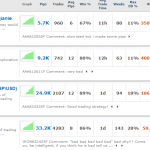Autotrading The New Social Trading – Tips

Autotrading in forex is a system where traders link up their accounts to that of other more successful traders on a platform so that the strategies that these successful traders use are duplicated on their own accounts automatically.
Forex autotrading should not be confused with automated trading (trading with forex robots). In forex autotrading, there are no robots or expert advisors involved. It is purely a case of “copy and paste” kind of trading. On some platforms (e.g. eToro), forex autotrading is known as social trading because it organizes traders into a community which follows the leader (the trader whose strategies are being copied).
Components of Autotrading
In order for an autotrading system to be setup, the following components must be in place:
a) There must be a platform on which the accounts of the lead trader and the subscribing trader are linked.
b) These linkage platforms are provided by either brokers or by third party providers. In some cases, brokers and these providers work in partnership to provide these platforms.
c) In some cases, both the lead traders and subscribing traders may be required to use an account from a single broker for seamless integration. This is the case with the forex autotrading facility of Avafx and eToro.
Types of Autotrading Platforms
There are three types of autotrading platforms:
a) Strict mirror traders
b) The Zulutrade autotrading platform
c) API autotraders
Forex Autotrading: Points to Consider
Before making the decision to use autotrading, there are factors to consider. If you use it, you are basically taking away the protective shell that shields your account and subjecting the fate of your money to someone else’s control. You do not even have the layer of protection that a PAMM account offers, so you have to be a lot more careful when using the social trading tool.
Before you select the trader on whose account yours will auto-trade there are parameters that must be considered. These parameters are used to gauge the performance of a lead trader as well as the safety of the trading method used by such a trader. A few of these parameters are listed below:
snapshot from Avafx/Zulutrade autotrader account
a) Number of pips made
b) Number of trades taken
c) Average number of pips per trade (easily tells you if the trader is a scalper, day trader, swing or position trader).
d) Win % ratio: This can be a deceptive factor as it is possible for someone to have a high win ratio and still lose money because of poor risk management strategies. This parameter must be weighed with the draw-down percentage.
e) Average trade time: This is the number of hours on the average that trades by the lead trader stay open. Also an indication of the kind of trader that person is.
f) Weeks active (will tell the intending subscriber about the lead trader's experience).
g) Draw-down percentage: This indicates the risk profile of the trader. Traders with high draw-down percentages are high-risk traders.
h) Return on investment (ROI).
i) Trader comments: Some of these can be very interesting as you can see from the snapshot, and gives an idea of the sentiment of traders following a particular strategy.
Snapshots like the one displayed give the intending auto-trade subscriber the opportunity to gauge the performance of signal providers before any commitment is made.
Some auto-trader services allow a prospective subscriber some time to test a particular provider on a demo platform to see the performance of the system. This is a brilliant way of judging the performance of a strategy before signing up. It's a good idea to use this facility before eventually signing up.


